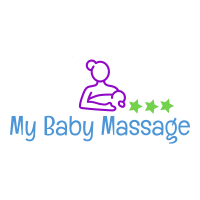Transcript: How Can Baby Massage Help You With Your Baby’s Non Verbal Communication?
This is a text transcript from The First Time Mum’s Chat podcast. The episode is called How Can Baby Massage Help You With Your Baby’s Non Verbal Communication and you can click on the link to view the full episode page, listen to the episode and view the show notes.
Having spent many years looking after babies and toddlers during my career as a child care educator and more recently as a baby massage instructor, I’m not surprisingly very much used to interpreting their often non-verbal communication. Many parents question me when I talk about this, saying such things as, “How can I communicate with my baby when we are unable to understand each other?”. This happens a lot when I’m teaching parents how to massage their baby using the baby massage techniques.
One of the important aspects of baby massages is that you always ask your baby’s permission before getting started, and many parents have no idea how to do this or interpret their baby’s body language. Just because they cannot communicate with you in words doesn’t mean there is no avenue of communication. So in this episode, I’m going to talk about ways to help you communicate with your baby and understand those non-verbal cues.
I also highly recommend checking out the podcast episode I did recently with Louise Day, who is a speech and language therapist titled, Tips to Engage With Your Child Using Nonverbal Communication, where you’ll hear other excellent tips and I’ll include a link to the location with you at the conclusion.
So let’s begin by exploring how your baby communicates without words. Broadly speaking, babies communicate by way of crying, babbling, squealing, eye contact, smiling and via body movement, such as moving their legs and arms. To help you, here are a few cues of how this communication could be interpreted when following the baby massage permission sequence that I mentioned earlier in this episode. When I ask the baby’s permission, I am looking for cues such as, are they smiling, are their legs and arms moving, are they excited, are they crying? If they’re not crying, but cooing or squealing with excitement and smiling, then it’s safe to interpret their body language is saying, yes, please I would love to have a massage.
Babies also communicate through their eyes and focus on your face. This teaches them the different facial expressions when they watch you and research has shown that when a baby gazes at its mother, their brainwaves are aligned and it boosts their learning and communication but when you are massaging your baby and you are talking to your baby, you are not only teaching them about massage strokes and about touch, but you are boosting their learning, you are boosting their vocabulary and you are increasing their communication as you’re talking to them and you are looking at your baby while you’re massaging them, and babies focus on your face and your smiles.
Research from the University of Cambridge in England showed that making eye contact with your baby, causes brainwave synchronization for both you and your baby. Furthermore, researchers believe this synchronization can help boost communication and learning skills and brain organization. So helping your baby to use all their senses helps them to learn and grow. So when you are massaging your baby and touching your baby, you are helping them to develop their senses because they are watching you, they are gazing at you, and they are learning to recognize your smell when you are massaging them and they’re also learning to recognize your voice as you are massaging them.
They actually learn this from a very early age, so can you imagine how important touch is when you are communicating with your baby? You are helping them to develop all of this and so, so much more. I always encourage moms to talk to their baby during massage because when you are talking to them, you are not only teaching them about the massage strokes and touch, but you are boosting their learning at the same time and as I’ve said before, you are boosting their vocabulary as you talk to them. They’re learning new words, they are learning ways to communicate with you as you talk to them. So how do babies learn? Babies learn with their senses, using their eyes, mouth, nose, ears, and hands to explore their world.
They observe the world whilst listening and checking things out with their hands and mouth, whilst also feeling with their hands. So encouraging your baby to use all their senses is certain to help them learn and grow and baby massages encourages touch and the development of their senses. As they watch and gaze at you, they’re developing all their senses, including their voice.
I know being a new mom is really hard and there are so many adjustments, it’s exhausting but one thing that I have learnt after working with parents for more than a quarter of a century is that it’s through our hands that we speak to a child that we communicate and touch is a child’s first language and understanding comes long after feeling and baby massage helps you to build your confidence and bond and connect with your baby so you have a happier and more contented baby.
I have put together a special course delivered via Zoom to help you to do this. It helps you to learn the techniques of baby massages so you too can build your confidence and bond and connect with your baby.
If you want to find out more about what I do and learn to communicate and touch your baby through the magic of touch, please go to Mybabymassage.net/zoom.
